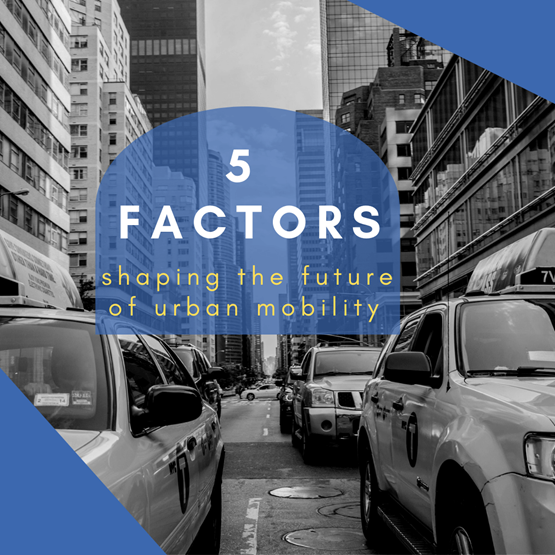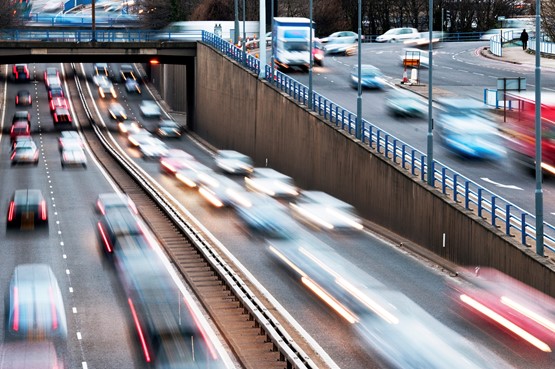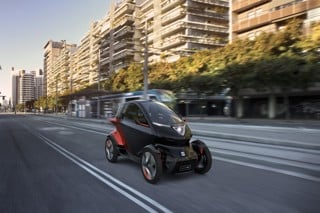This editorial feature appears in the February 21, 2019 issue of Fleet News and is sponsored by The AA and Goodyear
The UK is on the cusp of significant change in how people, goods and services move around, with increasingly crowded roads, high levels of pollution and new technologies set to spark a transport revolution. Andrew Ryan looks at five of the factors which will influence the future for urban travel.

1. Air quality
Air quality is arguably the issue which will be the biggest driver of change in urban mobility.
A Department for Environment, Food and Rural Affairs (Defra) report last year described it as “the largest environmental health risk in the UK”, while the Royal College of Physicians has linked 40,000 premature deaths in the UK each year to outdoor air pollution, with road transport responsible for some 80% of NOx at the roadside.
Read the sponsor's comment by Stuart Thomas, director of fleet and SME at The AA

Levels of nitrogen dioxide (NO2), mostly produced by diesel vehicles, have been illegally high since 2010 in the vast majority of urban areas in the UK, with the pollutant also linked to cancer, asthma, stroke and heart disease, diabetes, obesity and changes linked to dementia.
This has placed a previously unseen urgency on introducing measures to improve air quality and, in July last year, the Government published its plan for the transition to zero emission road transport – the Road to Zero.
This includes the ambition that by 2030 as many as 70% of new car sales and up to 40% of new van sales will be ultra-low emission (sub 50g/km), that no new petrol or diesel cars or vans will be sold by 2040, and that by 2050 almost every car and van will be zero emission, although ‘almost’ is not defined.
While widespread adoption of clean fuel technologies will reduce air pollution, many local authorities are taking more immediate action.
For example, in 2017, London introduced a toxicity charge for pre-Euro 4 cars and vans, while last year Hackney and Shoreditch introduced ultra-low emission streets which could be used only by vehicles with CO2 emissions below 75g/km.
READ MORE: why are fleet managers morphing into mobility managers?
On April 8 this year, an ultra-low emission zone (ULEZ) will be introduced for central London, where cars and vans must be at least Euro 4 (petrol) or Euro 6 (diesel) or face a £12.50 daily charge. Lorries face a £100 charge if they do not meet Euro VI standards.
“Our objective is not to be getting the £12.50 or the higher charges, it’s to get people to comply so we get the air quality benefits we need in London,” says Lilli Matson, director of transport strategy at Transport for London (TfL).
“It is important to emphasise that, although the standards of the ULEZ are around the Euro 6 diesel standard, ultimately the long-term vision is to make London a zero carbon city by 2050.
“This isn’t like we’ve chosen a completely ridiculous goal out of nowhere. This is completely what the experts are saying is needed to happen if we are seriously going to address climate change.”
The ULEZ will be expanded to include the inner London area bounded by the North and South Circular Roads on October 25, 2021.
The ULEZ model will be replicated in a number of urban areas across the UK from 2020 after the Government instructed five cities to investigate introducing a clean air zone (CAZ) by 2020 – Birmingham, Derby, Leeds, Nottingham and Southampton – while a further 23 local authorities were required to create plans based on single road exceedances.
Of these, Birmingham and Leeds have announced their plans for CAZs while Derby, Nottingham and Southampton have rejected them as they feel they can make the sufficient air quality improvements through other measures.
These include – dependent on the city – retrofitting buses with clean exhaust technology, revising taxi licensing conditions to remove the most polluting vehicles, and introducing a car scrappage scheme to encourage residents to move to lower emission cars.
Other local authorities are pushing ahead with their own plans to introduce CAZs.

Oxford last month revealed its proposals for a zero emission zone (ZEZ) which could see all non-zero emission vehicles banned in some areas of the city during certain hours from 2020, while Manchester mayor Andy Burnham has announced a proposal to introduce a CAZ for operators of buses, coaches, taxis, lorries and vans, as well as some private cars registered outside the area.
So how will CAZs affect fleets? In the main, not hugely if they operate cars. Euro 4 petrol accounts for most new petrol car sales after September 2006, with Euro 6 taking most new registrations of diesel cars from September 2015.
However, Birmingham, Bath, Bristol and Sheffield, among others, are including vans in their CAZ proposals. With many fleets operating light commercials over five years or more, this class of CAZ will affect them unless they defleet early and replace with Euro 6.
Research by the British Vehicle Rental and Leasing Association (BVRLA) shows that 75% of cars leased from its members already comply with CAZ requirements. However, just 37% of vans do.
And, operators of HGVs, which traditionally have longer operating cycles than cars and vans, are even more affected. They will also face higher penalties: for example, non-compliant HGVs will face a daily charge of £50 to enter the CAZs in either Birmingham or Leeds, and £100 in London.
“The decision to charge hauliers is short-sighted and very frustrating,” says Gerry Keaney, chief executive of the BVRLA. “It is an extra burden on operators who will have to pass costs on to the consumer.
“Unlike cars and vans, HGV operators have no option to go electric. Operators will face huge costs in replacing non-compliant vehicles with the latest trucks that meet Euro VI emission standards – there are no retrofit solutions available at present.
“We are particularly concerned about smaller businesses, many of whom operate on extremely tight margins and will not be able to upgrade their fleet in time.”
However, Birmingham recognises the likely impact on leased fleets and is asking central Government to give operators of non-compliant leased vehicles a year’s grace from the start of its CAZ next January.
2. Mobility as a Service
Mobility as a Service (MaaS) is the term for the digital platforms (often smartphone apps) through which people can access a range of public, shared and private transport, using a system that integrates the planning, booking and payment.
It is a market still in its infancy, but is being developed in response to the growing demand from users for transport to be delivered as an on-demand service that allows passengers to travel door-to-door conveniently and seamlessly.
“At some stage, apps will allow all of us to identify the most convenient, fastest or cheapest multi-modal way to travel from A to B, and the days of ‘default car’ for every journey will end,” says Ian Richardson, general manager at Fleet News sister brand Sewells Research & Insight, which has produced the British Business and Mobility Study report.
“In the corporate sector, the conditions are ripe for this approach with some employees.
“The current emphasis on employees sharing lifts both to work and to visit suppliers and clients is a natural, if accidental, stepping stone towards a future of shared travel via ride hailing, car sharing, on-demand bus services and public transport. Business customers are starting to wake up to these possibilities.”
In theory, MaaS could reduce congestion, improve air quality through the decreased vehicle use, and improve users’ health by encouraging increased use of active modes of travel such as walking and cycling.
In October last year, Fleetondemand launched its MaaS app for business, Mobilleo, following three years of research, development and testing.
Fleetondemand says the app integrates thousands of public and private transportation providers into a single, configurable platform.
It allows users to find, book and pay for their entire business journey (including parking, car hire, flights, trains, accommodation, restaurants, airport lounges, car clubs, buses and taxis), in one transaction.
Maas Global, meanwhile, launched its Whim app in the partnership with Transport for the West Midlands, part of the West Midlands Combined Authority, in April 2018 following a six-month trial.
It currently has commercial contracts with several transport operators: National Express West Midlands (bus and tram services), Enterprise (car hire) and Gett (taxi service). Bike-sharing (via Nextbike) and National Rail services (via On Track Retail) are expected to be introduced into the app soon.
Usage patterns indicate that early adopters – the company has not released figures for how many people have downloaded its app or signed up for its service since its launch – are using Whim for commuting.
However, Chris Perry, head of partnerships UK at MaaS Global, says: “We have not focused on business travellers and the products we have at the moment are about travelling around Birmingham and the West Midlands, whereas business travel tends to be long distance.
“But we think there will be a strong market for B2B and, once we have the ability to sell rail tickets, we think the product will be much more appealing to business customers.
“We want to learn what their needs are and want to build something that works for them.”
In a report published in December, a Transport Committee report overview into MaaS noted that it is widely thought within the transport industry that the Government will need to redirect existing funding or create new funding streams to ensure a range of MaaS pilots are effectively tested.
This is because current Government funding opportunities are insufficient and, as MaaS is relatively new, it cannot yet attract significant levels of investment from the private sector.
3. Fuel

The fuels used by road transport will continue to diversify in the future, with electrified freight and fleet vehicles expected to become the most common in urban areas.
That’s the view of Gavin Bailey, technical and business development manager at the Transport Research Laboratory (TRL).
“From our research on the Low Emissions Freight and Logistics Trial, electric road systems for Highways England and ECO Stars we have engaged with numerous operators,” he says.
“This has meant we have gained tremendous insight into the realistic capabilities of ultra-low and low-emission heavy goods vehicle and light goods vehicle technologies.
“It is likely, due to the current capabilities of the available technologies, that we will see a bias towards electrification of freight and fleet vehicles in urban areas, and a dominance of gas vehicles in long- to medium-haul journeys.”
The increasing uptake of electric vehicles will be driven mainly by the requirement to improve air quality in urban areas, the increasing availability and capability of EVs, and the expectation that prices of the vehicles will come down as the technology becomes more commonplace.
Electric powertrains are being backed extensively by manufacturers, with Reuters analysis last month showing that, globally, vehicle manufacturers had announced investments totalling more than £70 billion in the technology.
The expected growth in EV numbers will need to be reflected by an improved charging infrastructure, including in urban areas, a requirement recognised by Lilli Matson, director of transport strategy at Transport for London.
“We are already installing quite significant electric charging infrastructure in London,” she says. “There is a slow-charging infrastructure we have established and our efforts are now focused on deploying a rapid-charging infrastructure.
“Over the past year we delivered more than 100 rapid chargers and are working towards 300 over the next 18 months.”
The UK’s biggest trial of electric vehicles gets underway later this year involving UK Power Networks, Royal Mail, Centrica, Uber, SSE and Hitachi Capital. It will see 3,000 EVs deployed over the course of three years to help identify ways of overcoming the infrastructure concerns in urban, suburban and rural regions across the south and south-east England.
Industry analyst KPMG predicts electrification will dominate in lighter vehicles, with a plural fuel mix for medium/heavy vehicles over the next couple of decades.
By 2050, this will need to converge to a single/dual fuel mix due to infrastructure and sustainability requirements, with the Government’s policy stance critical in determining this fuel mix.
Elsewhere, changes to the Renewable Transport Fuel Obligation (RTFO) will double the use of renewable fuels in the UK transport sector within 15 years.
This will compel owners of transport fuel, who supply at least at least 450,000 litres a year, to make sure the mix is at least 12.4% biofuel by 2032. When the change was announced in April last year, the target had been 4.75%.
4. Driverless vehicles

Driverless vehicles have the potential to revolutionise the way goods and people are moved around urban areas.
The long-term benefits of automated transport are expected to be significant. A major one is expected to be increased safety as the technology has the potential to eliminate human errors which often contribute to collisions.
Fully automated systems are also predicted to radically reduce the number of vehicles on the road through increased ride sharing.
The technology will also produce cars that drive efficiently, and there could also be significant time savings as employees could work as they travel given they are freed up from driving.
While the futuristic vision of cities with robo-taxis and cargo pods buzzing seamlessly in and out of traffic may still seem like a far-flung idea, the day when fully-autonomous cars and vans are being used commercially is, possibly, not that far away. The UK Government has an ambition that driverless vehicles will be in use commercially by 2021 – a target that experts say is not out of the question.
“The technology exists, it’s certainly possible,” says Rob Wallis, chief executive of Transport Research Laboratory, who added that while high volumes are unlikely to be driving around independently, live services will be running by that time.
A number of driverless vehicle trials have been taking place around the UK to develop and gain an understanding of the technology.
These include the Gateway scheme in Greenwich, London, which saw a fleet of driverless pods provide a shuttle service to pick up and drop off passengers from four designated pod stops, as well as automated urban deliveries.
In October last year, a prototype self-driving Range Rover Sport successfully drove around the Coventry ring road, changing lanes, merging with traffic and exiting junctions at the speed limit of 40mph as part of the £20 million Government-funded UK Autodrive project.
The Venturer consortium is testing vehicles in the Bristol and South Gloucestershire areas, while private hire company Addison Lee and autonomous driving software specialist Oxbotica are in the process of creating detailed, digital maps of more than 250,000 miles of public roads in and around London, with a view to providing a self-driving car service by 2021.
However, Wallis says there are three current barriers to automated vehicles becoming a reality: the insurance industry, the regulatory environment and public perception.
“People want to know these technologies are safe, if they will decrease accidents and provide societal benefits surrounding road capacity and congestion,” he adds.
Fears have also been raised over the risks posed to driverless vehicles by hackers. To tackle this, the British Standards Institute has published a new cyber security standard for manufacturers to comply with, following consultation with academics and industry experts.
5. Congestion

The UK’s roads are getting more crowded, with many experts expecting the situation to get worse – particularly in urban areas.
Latest Department for Transport (DfT) figures show that the average speed of vehicles on ‘A’ roads in towns and cities dropped from 19.3mph in 2014 to 18.4mph in 2017.
All 10 of the slowest local authority areas in England are in London, with City of London having an average speed of 7.6mph. Manchester has the slowest speeds outside London at 15.3mph.
There are a number of reasons for this. One is the focus on making urban areas more pedestrian- and cyclist-friendly, while the volume of traffic has also grown.
In 2017, total motor vehicle traffic in Great Britain reached a new record level, with 327 billion vehicle miles travelled, a 1.3% increase compared with 2016.
Van traffic showed the fastest growth in percentage terms of vehicle types, rising 2.7% to hit a record high of 50.5bn vehicle miles in 2017.
The drivers of this rapid van growth could include the growth in internet shopping and home deliveries, with research showing that 77% of adults shopped online at least once during 2017, compared to 53% in 2008.
The DfT’s Road Traffic Forecasts 2018 report predicts that car traffic will grow between 11% and 43% by 2050, while light goods vehicle traffic will grow between 23% and 108%, which will further increase congestion.
Developments such as mobility as a service (see page 24) and autonomous vehicles (see page 26) are expected to have an effect on congestion. Companies are also developing alternative methods of delivering goods in urban areas, many of which are described as ‘last-mile’ solutions.
These range from urban consolidation centres where goods can initially be delivered before they are distributed to customers by a smaller number of vans, as well as the potential introduction of electrically-powered vans, micro vehicles and e-cargo bikes, which could provide a better service to customers for cargo in comparison to light commercial vehicles.
In September, the Government announced a £2 million funding pot to support fleets with the uptake of e-cargo bikes.
Its backing of e-cargo bikes is nothing new. In May, e-Cargobikes.com, with support from the Innovation Challenge Fund, collaborated with the supermarket chain Sainsbury’s to trial the use of electric cargo bikes to deliver groceries.
A fleet of five cargo bikes, each with a capacity of up to 480 litres and a payload of 125kg were introduced in South London, delivering up to 100 orders a day to customers who shopped via the retailer’s groceries online website.
Companies set goal of reducing business travel
The British Business and Mobility Study, produced by Fleet News sister brand Sewells Research & Insight, has found a significant proportion of companies are seeking both to reduce business travel and cut the number of employees commuting to the workplace.
The study of 1,000 business leaders found that:
- 66% of businesses have set targets to reduce their volume of internal travel
- 60% of businesses have targets to cut trips to suppliers
- 66% of businesses have targets to lower the number of journeys to clients
- 65% of businesses consider video conferencing as a viable alternative to business travel
 Over the next five years, a large proportion of UK fleets will be impacted by the introduction of various clean air zones across the country.
Over the next five years, a large proportion of UK fleets will be impacted by the introduction of various clean air zones across the country.
In central London, the Ultra-Low Emission Zone (ULEZ) scheme comes into force on in April. A £29 million ULEZ-style project has been announced to improve air quality in Leeds.
More clean air zones (CAZs) could follow as councils realise they have a new and reliable revenue stream. Indeed, Birmingham is proposing to introduce a Class D zone which could work in the same way as London’s ULEZ. These changes are more likely to affect small businesses whose fleet mix comprises older vehicles.
There is some light at the end of this tunnel for fleets. In Leeds, £23m has been set aside to help businesses make the transition. A £23m scrappage scheme has also been announced for London drivers to support the ULEZ introduction, designed to get the city’s most polluting vans off the road.
At The AA, we believe the Government also has a role to play in this, and that it should be providing more incentives to help businesses achieve this goal. Its ambition is to reach a position by 2030 in which at least 50% of new cars and vans sold in the UK will be ultra-low emission vehicles.
So why not incentivise businesses to move to this future more quickly via grants and scrappage schemes? We’re keen to help the fleet industry transition to an alternatively fuelled future, but we’re mindful that this won’t be achieved without support.
We urge the Government to act now to put business interests first.
- Visit theaa.com/business for more information

























Brian Oldham - 12/03/2019 23:35
Any plan that has a target of more than 20 years from now to save the planet from greenhouse gases is a plan to fail. Especially if that plan is set to keep at least 30% of vehicles producing greenhouse gas. You should be ashamed of yourselves.